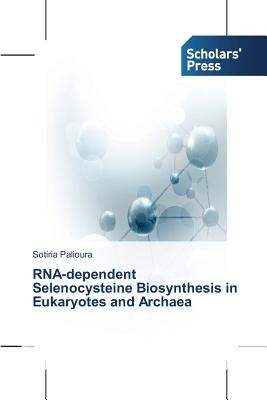
- We will send in 10–14 business days.
- Author: Sotiria Palioura
- Publisher: Scholars' Press
- Year: 2014
- Pages: 108
- ISBN-10: 3639709039
- ISBN-13: 9783639709032
- Format: 15.2 x 22.9 x 0.7 cm, softcover
- Language: English
- SAVE -10% with code: EXTRA
RNA-dependent Selenocysteine Biosynthesis in Eukaryotes and Archaea (e-book) (used book) | bookbook.eu
Reviews
Description
Selenocysteine (Sec), the 21st genetically encoded amino acid, is the major metabolite of the micronutrient selenium. Sec is inserted into nascent proteins in response to a recoded UGA stop codon. The substrate for ribosomal protein synthesis is selenocysteinyl-tRNA. The mechanism of Sec-tRNA formation was known in bacteria, but remained poorly understood in archaea and eukaryotes. Herein, biochemical and genetic data provide evidence that Sec-tRNA biosynthesis requires the tRNA-dependent conversion of O-phosphoserine (Sep) to Sec in eukaryotes and archaea. In this two-step pathway O-phosphoseryl-tRNA kinase (PSTK) first converts seryl-tRNA to Sep-tRNA, which is then the obligatory precursor for a Sep-tRNA: Sec-tRNA synthase (SepSecS). SepSecS used to be annotated as Soluble Liver Antigen/Liver Pancreas (SLA/LP) and is thought to be the antigen for a form of autoimmune hepatitis. The crystal structure of human SepSecS complexed with its substrates sheds light to the vitamin B6-dependent mechanism of Sec-tRNA formation. This report is useful to biophysicists, biochemists, and evolutionary biologists as well as to anyone investigating the role of SepSecS in autoimmune hepatitis.
EXTRA 10 % discount with code: EXTRA
The promotion ends in 17d.08:36:28
The discount code is valid when purchasing from 10 €. Discounts do not stack.
- Author: Sotiria Palioura
- Publisher: Scholars' Press
- Year: 2014
- Pages: 108
- ISBN-10: 3639709039
- ISBN-13: 9783639709032
- Format: 15.2 x 22.9 x 0.7 cm, softcover
- Language: English English
Selenocysteine (Sec), the 21st genetically encoded amino acid, is the major metabolite of the micronutrient selenium. Sec is inserted into nascent proteins in response to a recoded UGA stop codon. The substrate for ribosomal protein synthesis is selenocysteinyl-tRNA. The mechanism of Sec-tRNA formation was known in bacteria, but remained poorly understood in archaea and eukaryotes. Herein, biochemical and genetic data provide evidence that Sec-tRNA biosynthesis requires the tRNA-dependent conversion of O-phosphoserine (Sep) to Sec in eukaryotes and archaea. In this two-step pathway O-phosphoseryl-tRNA kinase (PSTK) first converts seryl-tRNA to Sep-tRNA, which is then the obligatory precursor for a Sep-tRNA: Sec-tRNA synthase (SepSecS). SepSecS used to be annotated as Soluble Liver Antigen/Liver Pancreas (SLA/LP) and is thought to be the antigen for a form of autoimmune hepatitis. The crystal structure of human SepSecS complexed with its substrates sheds light to the vitamin B6-dependent mechanism of Sec-tRNA formation. This report is useful to biophysicists, biochemists, and evolutionary biologists as well as to anyone investigating the role of SepSecS in autoimmune hepatitis.


Reviews